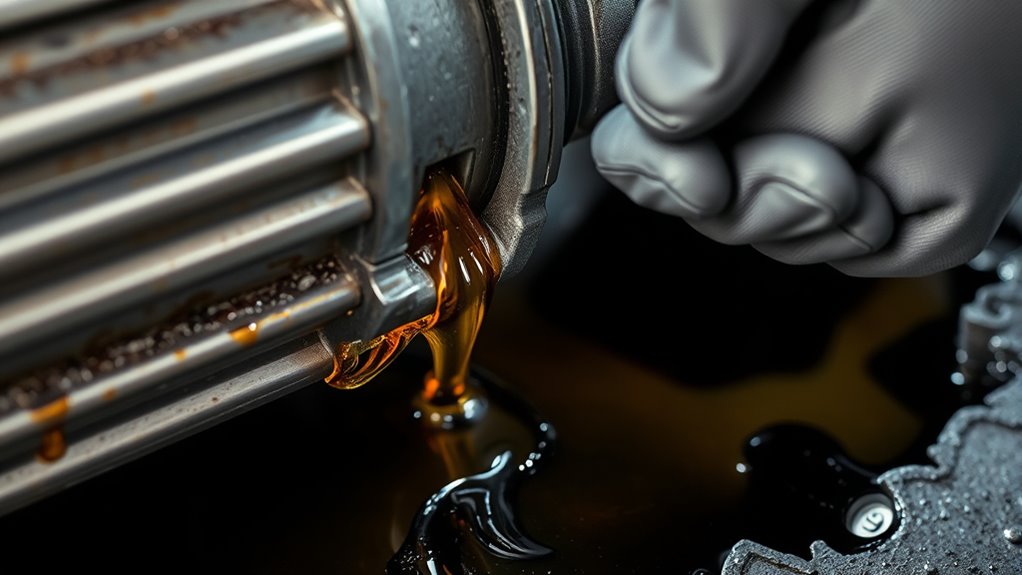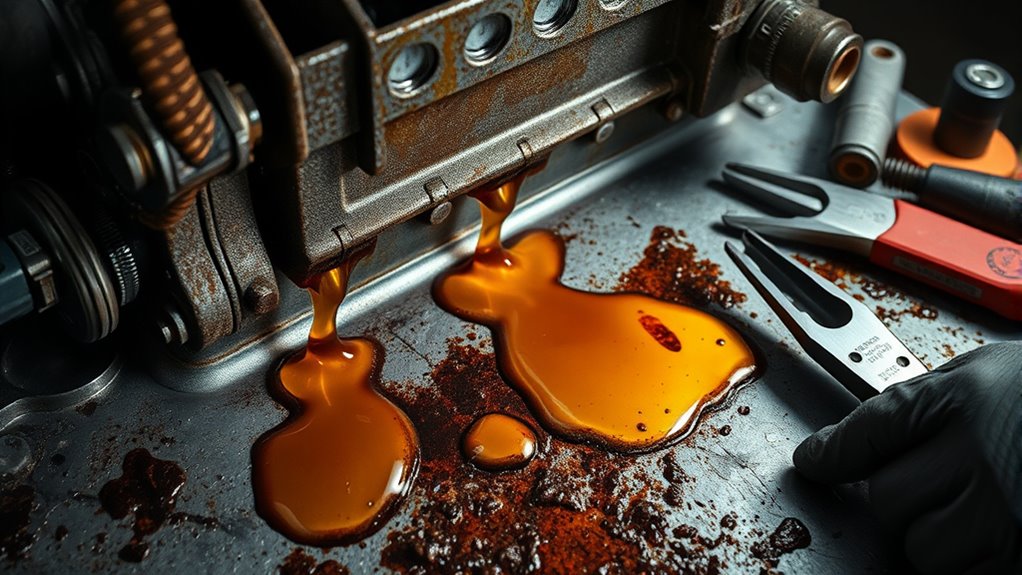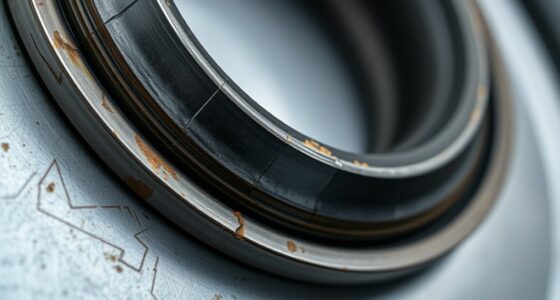To diagnose hydraulic oil leaks, look for visible stains, puddles, or leaks around seals, hoses, and fittings, especially during system operation. Check seals for cracks, hardening, or deformation, and monitor pressure fluctuations that can weaken seals over time. Tighten or replace worn or damaged seals with proper parts, and maintain steady pressure to prevent future leaks. If you want to learn more about effective repair techniques, keep exploring how to address this common issue.
Key Takeaways
- Inspect seals, hoses, and fittings for cracks, deformation, or leaks during system operation.
- Monitor pressure fluctuations with gauges to identify abnormal spikes or drops indicating seal issues.
- Look for visible oil stains, puddles, or stains around seals and connection points as leak indicators.
- Replace worn or damaged seals promptly with correct specifications to prevent further leaks.
- Conduct regular maintenance and pressure monitoring to reduce stress on seals and extend system longevity.

Hydraulic oil leaks are a common yet serious issue that can disrupt the operation of machinery and pose environmental hazards. When you notice a leak, it’s often caused by seal deterioration, which is a primary factor in many hydraulic system failures. Over time, seals can degrade due to exposure to heat, contamination, or wear, creating gaps that allow hydraulic fluid to escape. These worn seals are especially vulnerable during pressure fluctuations, which happen whenever the system experiences sudden changes in load or operation. As pressure rises and falls unpredictably, weakened seals struggle to maintain a tight seal, increasing the likelihood of leaks.
Seal deterioration during pressure fluctuations often leads to hydraulic oil leaks and system failures.
You need to understand that pressure fluctuations are normal in hydraulic systems, but they also accelerate seal deterioration if seals aren’t in good condition. When seals weaken, the hydraulic fluid is more likely to seep out at connection points, around pistons, or inside fittings. This not only reduces system efficiency but also leads to contamination and further damage. You’ll notice leaks more easily if you observe the machinery during operation, especially under high pressure. Leaks tend to appear around seals, hoses, or fittings, often leaving visible stains or puddles beneath the equipment.
To diagnose a leak caused by seal deterioration and pressure fluctuations, first inspect the seals closely. Look for signs of cracking, hardening, or deformation. If seals appear brittle or damaged, it’s a clear sign they’ve worn out and need replacement. Pay attention to areas where pressure changes are frequent, as these are the most vulnerable spots. When the system operates under fluctuating pressures, you might notice inconsistent performance, such as sluggish movement or erratic operation, which can also hint at seal issues. Using pressure gauges can help you monitor fluctuations; sudden spikes or drops often indicate that seals are no longer able to handle the stress, leading to leaks. Understanding the role of seal integrity in hydraulic systems can help prevent failures and extend equipment lifespan.
Once you confirm seal deterioration as the culprit, replacing the seals becomes your priority. Ensure you use the correct type and size, matching the manufacturer’s specifications. Before installing new seals, clean the surrounding surfaces thoroughly to prevent contamination. After replacing seals, check the system’s pressure levels and run it for a while, observing for any leaks or irregularities. Maintaining proper pressure and replacing seals at the first signs of wear can prevent larger leaks and more costly repairs down the line. Regular inspections and proactive maintenance are key to keeping hydraulic systems running smoothly and avoiding environmental hazards caused by oil leaks.
Frequently Asked Questions
How Often Should Hydraulic Oil Be Replaced to Prevent Leaks?
You should replace hydraulic oil every 1,000 to 2,000 hours of operation or annually, whichever comes first, to prevent leaks. Regular oil change frequency helps maintain proper viscosity and prevents contamination that can cause leaks. Follow leak prevention tips like inspecting hoses regularly, tightening fittings, and using quality seals. Consistent maintenance guarantees your hydraulic system runs smoothly, reducing the risk of leaks and costly repairs over time.
Can Hydraulic Oil Leaks Cause System Failure or Damage?
Like a ticking time bomb, hydraulic oil leaks can cause system failure or damage if ignored. Leak detection is vital to catch issues early, preventing costly repairs. When you notice leaks, seal replacement is often necessary to restore system integrity. Left unchecked, leaks can lead to reduced pressure, overheating, or component damage, ultimately compromising your equipment’s performance and lifespan. Regular maintenance keeps your system running smoothly and avoids major breakdowns.
What Safety Precautions Should I Take When Repairing Leaks?
When repairing leaks, you should always wear personal protective equipment like gloves and goggles to protect yourself from hot or pressurized oil. Make certain proper leak containment to prevent spills from spreading and causing hazards. Turn off the equipment and depressurize the system before starting repairs. Keep the work area well-ventilated, and have spill cleanup materials ready. Following these precautions helps keep you safe and minimizes environmental impact.
Are There Eco-Friendly Options for Hydraulic Oil?
You might be surprised to find eco-friendly options for hydraulic oil that actually work. Biodegradable lubricants and eco-friendly additives are designed to break down faster, reducing environmental impact. These alternatives can often match traditional oils in performance, so you don’t have to compromise quality for sustainability. Switching to these options helps protect ecosystems and promotes responsible maintenance, making your hydraulic system safer and more eco-conscious.
How Can I Prevent Future Hydraulic Oil Leaks Effectively?
To prevent future hydraulic oil leaks, you should regularly maintain seals and replace them when worn, ensuring they stay effective. Keep an eye on pressure regulation to avoid excessive strain on components, which can cause leaks. Follow a routine inspection schedule, address minor issues promptly, and use quality parts. Proper seal maintenance and consistent pressure regulation are key to avoiding costly leaks and maintaining system efficiency.
Conclusion
To prevent hydraulic oil leaks, you need to inspect regularly, identify issues early, and repair promptly. By checking hoses, fittings, and seals, you catch problems before they worsen. By maintaining proper fluid levels, tightening connections, and replacing worn parts, you keep your system running smoothly. Keep a close eye, stay proactive, and act swiftly—because catching leaks early saves money, prevents damage, and keeps your equipment performing at its best.









